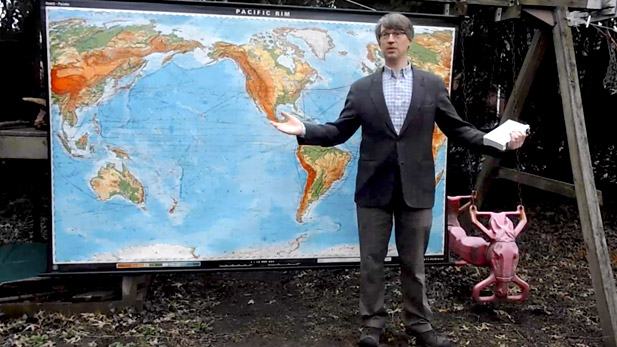Providing a Worldview, From a Professor’s Backyard

Through online lectures from his backyard or in fireside chats, professor Samuel Martland is providing students the same personable experiences as his campus classes examining Latin America and world history.
A sure sign of the spring season’s arrival at Rose-Hulman each school year has been those occasions when history and Latin American studies professor Samuel Martland has moved his classroom sessions outside on the lawn of the Root Quadrangle in the middle of campus.
Amid the COVID-19 public health crisis, the veteran college educator is still finding time to take his students outdoors while classes have been moved to the online learning environment. Martland recently attached a large map of Pacific Rim countries to a family swingset in his backyard to conduct lectures in his courses covering such topics as Latin America since 1800 and World History since 1400.
At other times, Martland has moved lectures indoors for fireside chats, literally, next to a fireplace in his family home or a makeshift studio in his basement, with a world map ever-present–reminiscent to his Moench Hall classrooms on campus.
“I have a motley collection of lamps going for light (in the basement studio). Most of what you see around me is stuff that’s usually in my office and that I often bring to class as props. Setting that up was kind of fun,” he says.
There’s been a smooth tradition to other aspects of online learning for Martland, since both of his courses depend heavily upon students reading books about course topics and then having discussions. Rather than hosting small- and large-group chats in a campus classroom, students exchange thoughts through online forums and write paragraphs together asynchronously by using Google Docs, Mind Meister and other online educational tools.
Rose-Hulman Art Curator Christy Brinkman-Robertson helped Martland find some images to improve his online course materials. Portraits of Domingo Faustino Sarmiento, an Argentine writer and political leader, and Juan Facundo Quiroga accentuated classroom discussions on the book “Civilization and Barbarism: Life of Juan Facundo Quiroga.”
Also, like the conventional classroom setting, most of a student’s online grade in Martland’s classes is still being predicated upon papers and long essay questions—for instance, how Latin America’s relationship with the rest of the world changed over a span of time—while 25 percent comes from short-answer test questions. Papers are being completed remotely and students can ask questions to Martland through email. The long essay questions also work well as take-home, open-book essay exams given over the course of a few hours.
“Things seem to be going pretty well so far, but it is definitely different. I think some people are finding it easier to participate. In general, students are saying a bit more in the forums than in person,” says Martland. “Some students are a bit more active in the courses than others. That’s always true, but connecting with people when we meet most days is different from connecting with people remotely.”
And, the professor hasn’t lost his sense of humor, despite conducting online sessions in a home with another college educator, a high school senior, an eighth-grader and family pets.
Asked how his outside lectures have been going, Martland stated, “The sound quality is harder out there. I had to keep waiting for (neighbors) to stop mowing.”